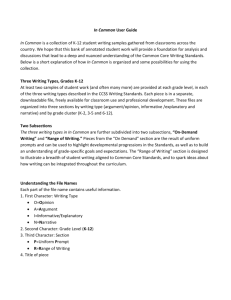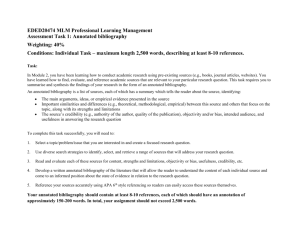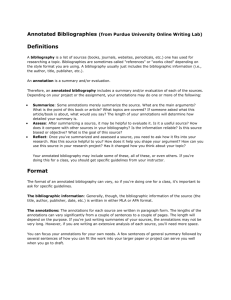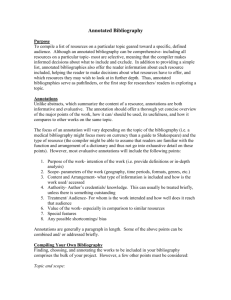BioGraph: Unsupervised Biomedical Knowledge Discovery via
advertisement
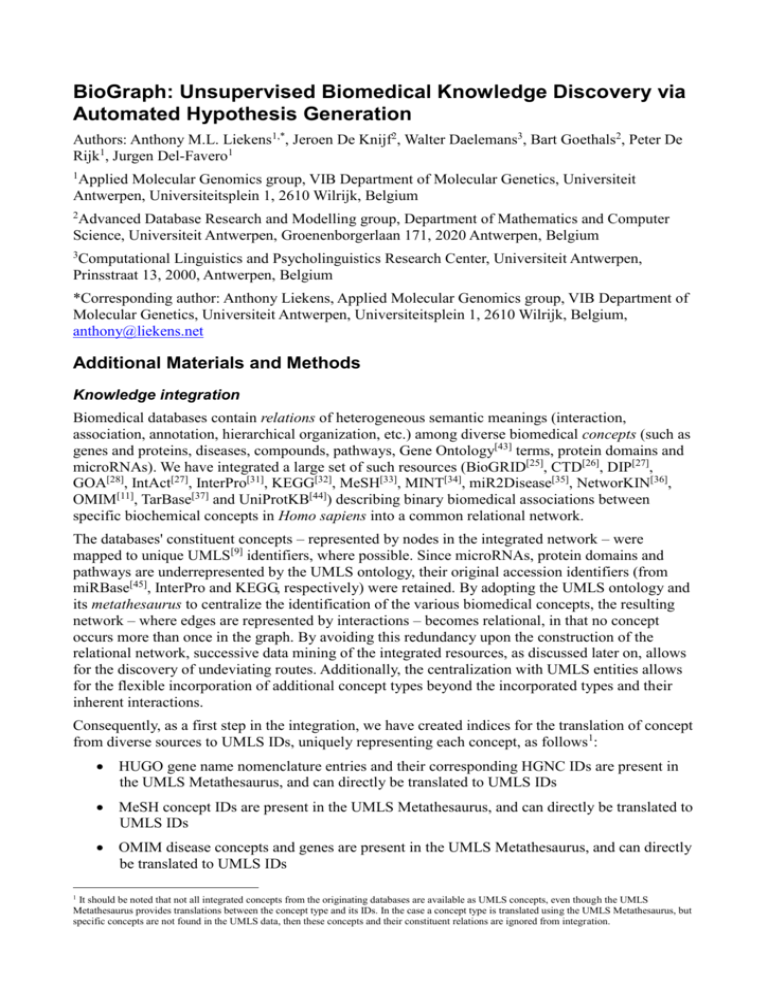
BioGraph: Unsupervised Biomedical Knowledge Discovery via
Automated Hypothesis Generation
Authors: Anthony M.L. Liekens1,*, Jeroen De Knijf2, Walter Daelemans3, Bart Goethals2, Peter De
Rijk1, Jurgen Del-Favero1
1
Applied Molecular Genomics group, VIB Department of Molecular Genetics, Universiteit
Antwerpen, Universiteitsplein 1, 2610 Wilrijk, Belgium
2
Advanced Database Research and Modelling group, Department of Mathematics and Computer
Science, Universiteit Antwerpen, Groenenborgerlaan 171, 2020 Antwerpen, Belgium
3
Computational Linguistics and Psycholinguistics Research Center, Universiteit Antwerpen,
Prinsstraat 13, 2000, Antwerpen, Belgium
*Corresponding author: Anthony Liekens, Applied Molecular Genomics group, VIB Department of
Molecular Genetics, Universiteit Antwerpen, Universiteitsplein 1, 2610 Wilrijk, Belgium,
anthony@liekens.net
Additional Materials and Methods
Knowledge integration
Biomedical databases contain relations of heterogeneous semantic meanings (interaction,
association, annotation, hierarchical organization, etc.) among diverse biomedical concepts (such as
genes and proteins, diseases, compounds, pathways, Gene Ontology[43] terms, protein domains and
microRNAs). We have integrated a large set of such resources (BioGRID[25], CTD[26], DIP[27],
GOA[28], IntAct[27], InterPro[31], KEGG[32], MeSH[33], MINT[34], miR2Disease[35], NetworKIN[36],
OMIM[11], TarBase[37] and UniProtKB[44]) describing binary biomedical associations between
specific biochemical concepts in Homo sapiens into a common relational network.
The databases' constituent concepts – represented by nodes in the integrated network – were
mapped to unique UMLS[9] identifiers, where possible. Since microRNAs, protein domains and
pathways are underrepresented by the UMLS ontology, their original accession identifiers (from
miRBase[45], InterPro and KEGG, respectively) were retained. By adopting the UMLS ontology and
its metathesaurus to centralize the identification of the various biomedical concepts, the resulting
network – where edges are represented by interactions – becomes relational, in that no concept
occurs more than once in the graph. By avoiding this redundancy upon the construction of the
relational network, successive data mining of the integrated resources, as discussed later on, allows
for the discovery of undeviating routes. Additionally, the centralization with UMLS entities allows
for the flexible incorporation of additional concept types beyond the incorporated types and their
inherent interactions.
Consequently, as a first step in the integration, we have created indices for the translation of concept
from diverse sources to UMLS IDs, uniquely representing each concept, as follows1:
HUGO gene name nomenclature entries and their corresponding HGNC IDs are present in
the UMLS Metathesaurus, and can directly be translated to UMLS IDs
MeSH concept IDs are present in the UMLS Metathesaurus, and can directly be translated to
UMLS IDs
OMIM disease concepts and genes are present in the UMLS Metathesaurus, and can directly
be translated to UMLS IDs
1
It should be noted that not all integrated concepts from the originating databases are available as UMLS concepts, even though the UMLS
Metathesaurus provides translations between the concept type and its IDs. In the case a concept type is translated using the UMLS Metathesaurus, but
specific concepts are not found in the UMLS data, then these concepts and their constituent relations are ignored from integration.
UniprotKB proteins are annotated by the HUGO names of their originating genes, which can
be translated to UMLS IDs as above
RefSeq[46] sequences are annotated by UniprotKB IDs, which can be translated to UMLS
IDs as above
Gene Ontology[43] term IDs are present in the UMLS Metathesaurus, and can directly be
translated to UMLS IDs
InterPro protein domains, repeats and other region types that are adopted for the annotation
of genes are not present in UMLS. Our list of UMLS concepts has consequently been
extended by the InterPro domain concepts to allow for these annotations, using their proper
IPR* identifiers.
KEGG pathways are only partly present in UMLS. The list of UMLS concepts has been
extended by KEGG pathway concepts to allow for gene-pathway annotations, using their
proper KEGG:hsa* identifiers
KEGG gene identifiers are annotated with their HUGO names, which can directly be
translated to UMLS IDs
KEGG enzyme identifiers are annotated with their Enzyme Commission identifiers, which
are linked with their corresponding genes represented as HUGO names, which can directly
be translated to UMLS IDs. Note that in the case of a KEGG enzyme, multiple genes may
be inferred from this translation
KEGG compound identifiers are annotated with their Chemical Abstracts Service (CAS)
registry numbers, which are present in the UMLS Metathesaurus and can be translated to
UMLS IDs
Disease Ontology[47] disease identifiers are present in the UMLS Metathesaurus, and can
directly be translated to UMLS IDs
The set of miRNA identifiers in the UMLS Metathesaurus is incomplete and the thesaurus
does not allow miRBase[45] identifiers to be translated to UMLS identifiers. All microRNAs
in the network are annotated with their miRBase identifiers and supplemented to the existing
concepts
Edges of the integrated relation network describe associations among the concept nodes in the
graph. The relations of the integrated databases provide different types of interactions, each with
specific semantic annotations. The integrated databases were chosen with respect to their ability to
describe elementary relationships that may yield chains of functional associations among more
distant concepts upon integration and consecutive analysis. BioGRID, DIP, IntAct and MINT
databases supply protein-protein interactions; gene-disease relations are extracted from OMIM and
CTD; CTD also provides associations among compounds on one hand, and genes and diseases on
the other; GOA and InterPro provide us with Gene Ontology annotations for genes and protein
domains; InterPro also provides protein domain and gene family annotations for proteins; pathway
memberships for proteins, and enzyme-metabolite relations have been extracted from KEGG;
hierarchical organization of diseases/compounds and families of diseases/compounds have been
integrated from MeSH; NetworKIN provides kinase-substrate relations; TarBase and miR2Disease
contains curated targets of microRNAs, where miR2Disease further contains miRNA-disease
associations. Additional databases with relationships capable of providing functional relationships
can effortlessly be integrated to extend the current network.
Extracting semantics from the integrated databases implies a different approach for each database.
1. Most databases (e.g., protein-protein interaction databases or gene ontology annotations)
only index one type of relation and do not offer any further clues on subtypes of this relation
(for example, types of PPIs, such as localization, binding, phosphorylation, … are missing),
so all relations extracted from these are annotated with the same relation type (e.g., “protein
interaction” or “annotation,” respectively).
2. Some databases, however, provide specificities of the relations in a limited ontology (e.g.,
CTD’s chemical-gene database provides types of interactions, e.g., “phosphorylation,”
“reaction,” “export,” “binding,” “expression,” …). Integrated relations were annotated with
their respective meanings in a common ontology that spans all databases (e.g.,
“phosphorylation” is used for all phosphorylation relations, independent from their origin
database)
The following list details the integration steps for each of the databases. If an integrated concept
needs to be translated to its UMLS ID, but UMLS (or its Additional concepts from InterPro, KEGG
or miRbase) does not contain an instance of this concept, the relation among the unknown concepts
is ignored.
BioGRID protein-protein interactions: Provided in TAB format from BIOGRIDORGANISM-Homo_sapiens-2.0.62.tab.txt from [49]. Interacting proteins are provided by
their HUGO gene names, which can directly be translated to UMLS accessions. Semantic
annotations: protein interaction, genetic interaction
CTD (The Comparative Toxicogenomics Database) gene-compound relations: Source [50].
Compounds are provided by their MeSH ID, genes by their HUGO names, which can
directly be translated to UMLS accessions. Semantic annotations: abundance, acetylation,
activity, acylation, alkylation, amination, binding, carbamoylation, carboxylation, chemical
synthesis, cleavage, cotreatment, degradation, ethylation, export, expression, farnesylation,
folding, geranoylation, glucuronidation, glutathionylation, glycation, glycosylation,
hydrolysis,hydroxylation, import, localization, metabolic processing, methylation,
mutagenesis, N-linked glycosylation, nitrosation, oxidation, phosphorylation, prenylation,
reaction, reduction, response to chemical, ribosylation, secretion, splicing, stability,
sulfation, sumoylation, transport, ubiquitination, uptake
CTD disease-compound relations: Source [51]. Compounds are provided by their MeSH ID,
diseases by their OMIM ID, which can directly be translated to UMLS accessions. Relations
are annotated with PubMed literature references. Semantic annotations: disease drug,
disease marker
CTD gene-disease relations: Source [52]. Genes are provided by theiur OMIM ID, genes by
their HUGO names, which can directly be translated to UMLS accessions. Relations are
annotated with PubMed or OMIM literature references. Semantic annotations: disease gene
DIP protein-protein interactions: Source [53]. Interacting proteins are provided as
UniprotKB or RefSeq IDs, which can be translated to UMLS accessions. Relations are
annotated with PubMed literature references. Semantic annotations: protein interaction
GOA gene ontology annotations: Source [54]. Genes are provided as their HUGO gene
names and ontology annotations are provided as their Gene Ontology IDs, which can
directly be translated to UMLS accessions. Relations are not annotated with literature
references. Semantic annotations: annotation
HPRD protein-protein interactions: Source [55]. Interacting proteins are annotated with their
HUGO gene names, which can directly be translated to UMLS accessions. Relations are
annotated with PubMed literature references. Semantic annotations: protein interaction
IntAct protein-protein interactions: Source [56]. Interacting proteins are annotated with their
UniProtKB accessions, which can be translated to UMLS accessions. Relations are
annotated with PubMed literature references. Semantic annotations: protein interaction
InterPro gene-domain associations: Source [57]. Genes are annotated with their HUGO
names, which can directly be translated to UMLS accessions. Protein domains are annotated
by their InterPro accessions denoting protein domains, repeats and other regions, which are
not available in UMLS. The accession numbers from InterPro have been supplemented to
the list of UMLS accessions to allow for the inclusion of these annotations in the integrated
network. Relations are not annotated with literature references. Semantic annotations:
annotation
InterPro gene-gene family annotations: Source [58]. Genes and gene families are provided
as InterPro accession identifiers, which are not available in UMLS and have been
incorporated in the concept accession list. Relations are not annotated with literature
references. Semantic annotations: ontology
InterPro gene-GO term annotations: Source [58]. InterPro concepts are provided by their
InterPro accession identifiers, which are not available in UMLS and have been incorporated
in the concept accession list. Gene ontology annotations for these domains are provided by
their Gene Ontology identifier, which can directly be translated to UMLS identifiers.
Relations are not annotated with literature references. Semantic annotations: disease gene
KEGG gene-pathway associations: Source [59]. Genes are provided by their HUGO names,
which can directly be translated to UMLS accessions. Pathways of which these genes are
part, can either be part of UMLS, or not. In the case that a KEGG pathway identifier is
indeed present in UMLS’ concepts, the UMLS Metathesaurus allows for the direct
translation of a KEGG identifier to a UMLS accession number. In the other cases, the
pathways are missing from UMLS but have been supplemented to the list of concepts.
Relations are not annotated with literature references. Semantic annotations: pathway gene
KEGG gene-compound associations: Source [60]. Contrasting with the other integrations of
knowledge databases, KEGG’s associations between genes and their proteins’ metabolites
have not been downloaded, but were extracted from the KEGG database by accessing its
web services. As our initial resource, we adopt KEGG’s enzyme database
(ftp://ftp.genome.jp/pub/kegg/ligand/enzyme/enzyme). By iterating over all enzymes in this
database, we can extract enzyme-compound and enzyme-coding gene relations using the
web service, where the enzymes are provided as Enzyme Commission numbers, compounds
are provided as KEGG compound instantiations and genes are denoted by their KEGG gene
identifiers. Multiple relations between genes and their enzymes’ metabolites can thus be
inferred and indexed using UMLS identifiers, provided with the translation indices as
discussed above. Relations are not annotated with literature references. Semantic
annotations: reaction
MeSH disease-disease family annotations: Source [61]. Diseases and disease families are
annotated with their MeSH identifiers, which can directly be translated to UMLS IDs.
Relations are not annotated with literature references. Semantic annotations: ontology
MINT protein-protein interactions: Source [62]. Interactions are annotated by their
interacting genes’ UniProt or RefSeq identifiers, which can directly be translated to UMLS
IDs. Relations are annotated with PubMed literature references. Semantic annotations:
protein interaction
miR2Disease microRNA-disease associations: Source [63]. Diseases are annotated with
Disease Ontology identifiers, which can directly be translated to UMLS IDs. miRNAs are
annotated with their miRBase identifiers, which are supplemented to the list of concepts.
Relations are annotated with article titles and publication years, which have not been
translated and incorporated into the databases, since the automated translation of these
literature references does not allow for a straightforward computational identification of the
database’s literature references. Semantic annotations: disease miRNA
miR2Disease microRNA-gene targeting: Source [64]. Genes are annotated with their HUGO
names, which can directly be translated to UMLS IDs. miRNAs are annotated with their
miRBase identifiers, which are supplemented to the list of concepts. Relations are annotated
with article titles and publication years, which have not been translated and incorporated
into the databases, since the automated translation of these literature references does not
allow for a straightforward computational identification of the database’s literature
references. Semantic annotations: miRNA target
NetworKIN kinase-substrate annotations: Source [65]. Kinases and substrates are annotated
with their HUGO gene names, which can directly be translated to UMLS IDs. Relations are
not annotated with literature references. Semantic annotations: phosphorylation
OMIM morbid map disease-gene associations: Source [66]. Diseases and genes are provided
as their OMIM identifiers, which can directly be translated to UMLS identifiers. References
to the literature are available through textual OMIM entries. Relations are annotated to
reference this support. Semantic annotations: disease gene
OMIM disease-disease relations: Source [67]. An OMIM disease is said to be related to
another disease if a synonym of the OMIM disease contains a substring (separated by “,”,
“and”, “of” or “with”, with “type” and numbers removed) that is the name or synonym of
this other disease in UMLS. For example, Charcot-Marie-Tooth, type 4C is subsequently
related to Charcot-Marie-Tooth. The originating OMIM identifier can be directly translated
to an UMLS identifier and is, as a result of this extraction, related to an UMLS identifier.
Semantic annotations: disease substring
TarBase miRNA-gene targeting: Source [68]. Genes are annotated with their HUGO names,
which can directly be translated to UMLS IDs. miRNAs are annotated with their miRBase
identifiers, which are supplemented to the list of concepts. Relations are annotated with
PubMed literature references. Semantic annotations: miRNA target
Quality control of the integrated databases
In order to check the quality of the integrated databases, we have repeated the Endeavour
benchmark for sets of the databases, by leaving out each database from the data integration and
assessing the database’s influence on the benchmark. This assessment was performed on the data as
integrated in May 2010, with an AUC of 91.31% if all databases are integrated. Additional Table 3
provides AUCs of the integrated network for each of the databases that were left out for this
assessment.
If a database is left out and the benchmarking results increase significantly, this means that
the database has a negative effect on the ranking algorithm, presumably due to the low
quality of relations in this database. No databases have been found to have a significantly
negative effect on the benchmark where some databases have a slightly negative effect on
the performance. Since none of these is significant and since the integrated knowledge from
these databases is (subjectively) found to be helpful in the construction of functional
hypotheses, these databases have not been removed from the integration.
If the impact of leaving out a database is significantly decreasing the AUC for the
Endeavour test, this database is crucial for the predictive capabilities of BioGraph. CTD
gene-disease associations, Gene Ontology Annotations and Medical Subject Headings have
been found to have a significantly negative impact on the benchmark, and are consequently
considered to be crucial for the scores reported in the manuscript.
Detecting hub nodes by computing a priori probabilities with random walks
A proven technique to detect hubs in a small-world network is to analyze stochastic random walks
on the network. Determination of the steady state behavior or limit behavior of performing an
infinite stochastic random walk on a network provides a method that measures the relative
importance of nodes in a network and ranks authoritative nodes by computing the probability of
ending up in a node when performing an infinite random walk on the network.
The algorithm for determining hubs is related to Google’s PageRank[10], used to detect prominent
web sites in Internet searches. The algorithm is based upon the notion of a network crawler that
visits concepts in the network while randomly following the links between them and thus more
frequently visiting authoritative concepts or hubs. Hubs are important but generic concepts,
unspecific for the discovery of related concepts in biomedical contexts, such as diseases, pathways,
etc. Since high ranking hubs are detrimental to our search for specific concepts with respect to a
context, we adopt a concept’s a priori probability to penalize its ranking with respect to its a
posteriori relatedness to a contextual concept.
In our setting, the stochastic algorithm for determining the prior probabilities of visiting concepts
during an infinite random is applied to measure the relative importance or connectedness of the
nodes in the integrated network of biomedical concepts, where the probability of randomly visiting
a node is bigger for highly connected nodes, thus detecting hubs as highly probable visited nodes.
The computation of a node’s prior probability is straightforward; (1) The network is represented as
a probability transition matrix with no damping (i.e., Google’s original implementation of
PageRank adopts a damping factor 0.85, we adopt a damping factor 1). (2) The importance or
ranking score of a node i, i.e., the steady state probability of visiting a node i, is given by the ith
element of the transition matrix’ steady state limit distribution or its unique eigenvector with
eigenvalue 1, provided that the transition matrix defines an ergodic Markov chain, which is
guaranteed if the network is irreducible and aperiodic (this has been verified for the BioGraph
integrated knowledge base). We have adopted the Power Method, optimized for the inherently
sparse transition matrix, to compute an approximation of this long term or steady state probability
distribution over the concepts. The construction of the integrated network’s transmission matrix is
slightly different from PageRank in that the original algorithm assumes a directed graph, where our
network consists of essentially undirected relations. We consider each undirected relation in the
integrated network as two symmetrical bidirectional edges in order to perform the network analysis
algorithm to compute the prior score of the concepts.
More specifically, we represent the graph with n concepts as its Markov chain denoted by an n x n
modified adjacency matrix M’. For its construction, we first consider the adjacency matrix M of the
graph, where an element Mi,j is 1 if there’s a relation between concepts i and j and 0 otherwise. Note
that since the relations in the integrated network are bidirectional, Mi,j equals Mj,i for all i, j. To
obtain the stochastic transition matrix M’, we divide each element by its column sum to guarantee
all column sums are 1. M’ now represents the transition probability matrix of the stochastic random
walk on the graph where M’i,j represents the probability to visit state or concept i in the next step if
the current state of the random walk is j. Since the matrix representing the random walk is
irreducible and aperiodic and thus ergodic, the limit distribution of the random walk is the unique
dominating eigenvector m* with eigenvalue 1 of the modified adjacency matrix M’ with
where m is any initial probability vector over the states of the Markov chain, following the PerronFrobenius theorem. The Power Method[48] computes an approximation of the limit distribution, by
selecting an initial vector m (in our case, this initial vector is the uniform distribution of
probabilities over all states or concepts of the graph) and repeatedly multiplying this vector by the
modified adjacency matrix M’ until it has sufficiently converged. In our case, we consider the
vector to have converged if the maximal difference between two consecutive vectors of the
algorithm no longer decreases. Consequently, the algorithm stops when the algorithm hits the
precision of floating point operations on doubles, in this case adopting the IEEE-754 double
implementation of Mac OS X.
The resulting vector m* now provides a numerically sufficient approximation of the probabilities
that a random walk visits each node i with probability m*i, also designated the ranking score, steady
state probability or the prior accessibility of the concept in the network. Top ranking concepts in the
integrated network are shown in Additional Table 1. The top ranking concept in the network is the
Gene Ontology term “Protein binding,” with a probability 0.007, indicating that this concept is
visited about once in every 135 steps of a stochastic random walk on the integrated network.
Computing a posteriori probabilities and ranking relations
In similarity to the algorithm for computing prior probabilities, we can compute the a posteriori
probabilities to visit any concept with respect to a source concept or source node by performing
random walks on the network. Instead of using an infinite random walk, as above, we randomly
restart the random walk in the source concept, according to a damping factor, such that the
probability of visiting a node nearby the source is expected to be higher than the probability of
visiting a node further away from the source node. With a damping factor set at 0.75, the random
walk is restarted in the source concept with a probability of 0.25 at each step taken in the random
walk. In similarity with the above algorithm for determining prior probabilities, we can describe the
random walk with restarts in the source concept as a probability transition matrix and compute its
steady state behavior distribution with the Power method.
More specifically, we define the adjacency matrix M as above. For the modified version M’’ that
represents the Markov chain of the random walk with restarts, we calibrate each column to
represent probabilities with column sums 1 and multiply each element by the damping factor D.
Finally, we add (1 - D) to each element on the sth row where s denotes the index of the source
concept, such that the column sums of the matrix are again 1. The resulting matrix M’ now
represents the transition probability matrix of the Markov chain that represents the random walk
with restarts in concept s, whose limit behavior can be computed using the Power Method to
determine the limit distribution of the stochastic model. As a result, the a posteriori probability
distribution assigns the highest probabilities to the nodes that are most accessible from the source
concept.
A ranking based on this a posteriori probability distribution would assign a high ranking to target
concepts close to the source concept in the network topology. As discussed before, the integrated
network has small world properties and highly unspecific hub would rank high for any source
concept because these hubs are highly accessible from any source concept. In order to rank concepts
specific to the source concept s, we compute the score of each ith concept as the ratio of its a
posteriori probability and square root of its a priori probability, with
We adopt this ratio as the ranking score for concepts in relation to the source concept s. With this
score, concepts are ranked by their vicinity to the source concept, but hub concepts are penalized by
their prior accessibility in the global network.
Backtracking heuristic for the automated generation of functional hypotheses
The set of k shortest or most probable paths that connect a source and target concept is adopted as a
set of functional hypotheses to support highly connected source and target concepts. The set can be
determined heuristically with a backtracking algorithm, starting from the target concept to find
highly probable paths leading toward the source concept, as depicted in Figure 2. The proposed
heuristic is based on estimating probabilities to traverse the graph adopting the pre-computed
posterior probabilities of each concept in the network with respect to the source concept.
Assume a source concept s and a target concept t in the integrated network. Let a simple path
between s and t be defined as an ordered list
P = { s, intermediate1, …, intermediaten, t }
where each concept in the list is unique and there exists a relation in the network for each of the
consecutive nodes in the path, i.e., ( s, intermediate1 ), ( intermediate1, intermediate2 ), …, (
intermediaten, t ) are all edges of the network. The probability of a random walker to traverse this
path, provided it starts in s and ends in t equals
1 / #neighbors( s ) Πi=1 … n #neighbors( intermediatei )
where #neighbors( i ) denotes the number of neighbors of node i in the network.
In order to find highly probable paths leading from s to t, we find the most accessible neighbor
concepts, starting backwards from t with respect to s, moving toward s. At each iteration of the
heuristic, we expand the set of neighbors backward to the source concept and prune the set of
generated partial paths — with respect to the probability of following this path in a random walk —
to a workable number (sufficiently larger than k). Eventually, this set of highly accessible paths
traces back to the source concept, thus generating a set of highly likely functional paths grounding
the indirect relation between the source and target concepts.
More specifically, consider a partial path P’ in the backtracking algorithm with some intermediate
concepts and the target concepts t, as follows
P’ = { intermediate1, intermediate2, …, t }.
We can estimate the probability to follow this partial path in a random walk from s to t by
considering the posterior probability to arrive at the first intermediate concept of this path with
respect to the source concept s, and by computing the probability for a random walk to follow the
path under construction from this first intermediate concept onward to reach the target t, with
Pr( P’ ) ~ posterior( intermediate1, s ) / Πi=1..#intermediates #neighbors( intermediatei ).
(1)
The algorithm for backtracking paths, to find k paths from s to t by backtracking the paths from
target t and and by pruning this set to K (>>k) paths at each iteration, is provided in the following
pseudo code:
S = { { t } }
//
Repeat
S’ = {}
For each path P = { a, b, …, t } in S
If a == s
//
S’ += P
Else
//
For each neighbor n of a
If n is not in P
//
S’ += { n, a, b, …, t }
End
End
End
End
S = Prune S’ to K most likely paths //
Until at least k paths in S start in s
Return top k paths in S
//
initial set of paths contains target
path reached s, do not extend
extend path toward neighbors
avoid cycles
adopt probability estimate as in (1)
probability can be exactly computed
At each iteration of the algorithm, we start with a set S of partial paths, extend this set of paths by
prepending neighbors to each one of the paths and prune this new set such that only the most likely
paths according to the estimation as in (1) remain. Initially, S contains one partial path, which only
has the target concept, i.e., S ={ { t } }. A each iteration we replace each path { a, b, …, t } in the
set of partial paths by a new set of partial paths, i.e., for each neighbor n of a, we add a new path {
n, a, b, …, t } to the set of partial paths. Note that we do not extend a path to a neighbor if the path
already contains the neighbor, to avoid cycling and in order to end up with simple paths. Paths that
have found their way to the source concept are no longer extended, but remain in the set and remain
putative candidates for pruning. At the end of each iteration, we prune the new set of paths such that
its K most probable paths, according to the estimate as in (1), remain. We keep extending likely
partial paths to their neighbors and pruning the set of paths to K paths until a sufficient number k of
paths have been found that connect s and t. We consider these paths as highly likely paths (which is
a heuristic but deterministic approximation of the set of most probable paths to traverse the graph
from s to t).
For the generation of hypotheses, we request k =10 paths and we prune the set to the K = 100 most
probable of its partial paths at each iteration. In our implementation, we only extend each of the
paths to their K most likely neighbors, to save on computation and pruning time. On the full
network, the computation of these highly likely paths for the random walk to traverse from s to t
can be computed in no more than a few seconds.
Additional Results
Disease-gene prioritization benchmark
All of the diseases and their causal genes have been represented as UMLS concepts to test their
relatedness with our prioritization platform.
Additional Tables
Rank Concept
1
2
3
4
5
6
7
8
9
10
11
12
13
14
15
16
17
18
19
20
21
22
23
24
25
26
27
28
29
30
31
32
33
34
35
36
37
38
39
40
41
42
43
44
45
46
47
48
49
50
Protein Binding
Cell Nucleus
Cytoplasm
integral to membrane
Membrane
Cell membrane
Metal Ion Binding
zinc ion binding
Extracellular
ATP binding
Protoplasm
DNA Binding
Signal Transduction
nucleotide binding
Selenium
Vitamin E
Regulation of transcription, DNA-dependent
receptor activity
Cytoplasmic matrix
G-protein coupled receptor protein signaling pathway
Fluorouracil
Tretinoin
tert-Butylhydroperoxide
Oxidation-Reduction
transferase activity
Selenite
transcription factor activity
Estradiol
Mitochondria
Transcriptional Regulation
integral to plasma membrane
Hydrolase activity
Adenosine Triphosphate
multicellular organismal development
Endoplasmic Reticulum
Water
Progesterone
TP53 gene
Calcitriol
Golgi Apparatus
decitabine
RNA Binding
Calcium Valproate
Biological Transport
Hydralazine
Doxorubicin
GRB2 gene
calcium ion binding
Extracellular Space
Adenosine Diphosphate
Type
UMLS ID Probability
Function
Component
Component
Component
Component
Component
Function
Function
Component
Function
Component
Function
Function
Function
Compound
Compound
Function
Function
Component
Pathway
Compound
Compound
Compound
Function
Function
Compound
Function
Compound
Component
Function
Component
Function
Compound
Function
Component
Compound
Compound
Gene
Compound
Component
Compound
Function
Compound
Function
Compound
Compound
Gene
Function
Other
Compound
C0033618
C0007610
C0010834
C1167322
C0596901
C0007603
C1323274
C1148621
C0521119
C1148923
C0175996
C1148673
C0037083
C1148916
C0036581
C0042874
C1158791
C1152633
C1383501
C1155412
C0016360
C0040845
C0076150
C0030012
C1151895
C0036580
C1148759
C0014912
C0026237
C1158770
C1167220
C1149632
C0001480
C1817464
C0014239
C0043047
C0033308
C0079419
C0006674
C0018042
C0049065
C1148846
C0006724
C0005528
C0020223
C0013089
C1333707
C1148580
C0015352
C0001459
0.00739
0.00559
0.00527
0.00522
0.00471
0.00322
0.00305
0.00235
0.00233
0.00231
0.00230
0.00220
0.00217
0.00216
0.00156
0.00150
0.00146
0.00146
0.00137
0.00131
0.00131
0.00130
0.00129
0.00127
0.00126
0.00124
0.00121
0.00116
0.00114
0.00114
0.00114
0.00106
0.00102
0.00102
0.00095
0.00092
0.00091
0.00090
0.00089
0.00085
0.00084
0.00082
0.00082
0.00081
0.00079
0.00079
0.00078
0.00076
0.00076
0.00075
Additional Table 1: Top 50 hubs or highest ranking concepts of the computation of the a priori rank
score in the integrated network. The probability denotes the chance to arrive in a concept at any
given time when randomly walking on the integrated network. The top concept, Protein binding, is
visited approximately once every 135 steps of a random walk on the network. For the prioritization
of concepts with respect to a source concept, these hubs are penalized as they are less specific for
identifying source-specific targets.
Disease
Alzheimer's Disease
Amyotrophic Lateral Sclerosis
Anemia
Anemia, Hemolytic
Breast Carcinoma
Carcinoma of the Large Intestine
Cardiomyopathies
Cataract
Charcot-Marie-Tooth Disease
Deafness
Diabetes
Dystonia
Ehlers-Danlos Syndrome
Epilepsy
Ichthyoses
Leukemia
Lymphoma
Mental Retardation
Muscular Dystrophy
Myopathy
Neuropathy
Obesity
Parkinson Disease
Retinitis Pigmentosa
Spastic Paraplegia
Spinocerebellar Ataxias
Usher Syndromes
Xeroderma Pigmentosum
Zellweger Syndrome
Mean
Standard deviation
Genes tested UMLS ID
7
4
43
13
23
21
22
20
14
41
26
5
10
15
9
109
30
24
24
41
18
13
9
30
7
7
7
10
9
C0002395
C0002736
C0002871
C0002878
C0678222
C0009402
C0878544
C0086543
C0007959
C0011053
C0011847
C0013421
C0013720
C0014544
C0020757
C0023418
C0024299
C0025362
C0026850
C0026848
C0442874
C0028754
C0030567
C0035334
C0037772
C0087012
C0271097
C0043346
C0043459
AUC
0.963175
0.856323
0.886218
0.96217
0.943615
0.955415
0.985262
0.948638
0.899821
0.888322
0.914281
0.878357
0.915361
0.953232
0.973799
0.861285
0.793848
0.851548
0.931996
0.919949
0.872345
0.958196
0.959322
0.984988
0.917061
0.982104
0.994581
0.997845
0.998842
92.92%
5.20%
Additional Table 2: Area Under the Receiver Operator Characteristic (ROC) Curve (AUC) for the
prioritization of disease genes in the Endeavour benchmark.
Left out database
BioGRID
CTD compound-gene
CTD compound-disease
CTD gene-disease
DIP
GOA
HPRD
IntAct
InterPro domains
InterPro ontology
InterPro GO annotations
KEGG pathways
KEGG metabolites
MeSH
MINT
miR2Disease miRNA-target
miR2Disease miRNA-disease
NetworKIN
OMIM
TarBase
AUC (March 2010)
Baseline: 91.31
91.42
91.43
91.44
85.44
91.29
84.80
91.38
91.43
91.29
91.31
91.31
91.12
91.22
89.25
91.35
91.39
91.53
91.33
91.44
91.33
Additional Table 3: Effect on the Endeavour benchmark after leaving out each separate database
from the data integration process.



